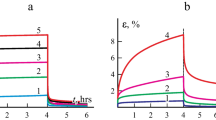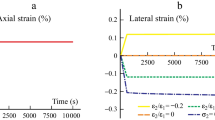Abstract
The Rousselier model has been used in the literature to model ductile failure of plastic materials. An extension of the Rousselier model to account for strain rate and temperature dependence is proposed in this work. The model is based on the definition of an effective scalar stress which depends on the porosity. Tests carried out on tensile round notched bars are used to validate the model after which it is applied to simulate the Charpy test.
Similar content being viewed by others
References
Abouaf, M., Chenot, J., Raisson, G. and Bauduin, P. (1988). ‘Finite element simulation of hot isostatic pressing of metal powders’. Int. J. Numerical Methods Eng. 25(1), 191–212.
AFNOR (1990). Essai de flexion par choc sur éprouvette Charpy. Partie 1: méthode d'essai. Association française de normalisation, La défense, France.
Anand, L., Kim, K. and Shawki, T. (1987). Onset of shear localization in viscoplastic solids. J. Mech. Phys. Solids 35(4), 407–429.
Barbier, G., Benallal, A. and Cano, V. (1998). Relation théorique entre la méthode de perturbation linéaire et l'analyse de bifurcation pour la prédiction de la localisation des déformations. Comptes rendus de l'Academie des Sciences 326(3), 153–158.
Basu, S. and Narasimhan, R. (1999). A finite element study of the effects of material characteristics and crack tip constraint on dynamic ductile fracture initiation. J. Mech. Physics Solids 47, 325–350.
Benzerga, A. and Besson, J. (2001). Porous plastic potentials for anisotropic solids. Europ. J. Mech. 20(3), 397–434.
Besson, J. and Abouaf, M. (1992). Rheology of porous alumina and simulation of hot isostatic pressing. J. Amer. Ceram. Soc 15, 2165–2172.
Besson, J., Brocks, W., Chabanet, O. and Steglich, D. (2001a). Ductile rupture of aluminum sheet materials. Europ. J. Finite Elements 10, 401–415.
Besson, J. and Foerch, R. (1997). Large scale object-oriented finite element code design. Computer Meth. Appl. Mech. Engineering 142, 165–187.
Besson, J., Steglich, D. and Brocks, W. (2001b). Modeling of crack growth in round bars and plane strain specimens. Int. J. Solids Struct. 38(46–47), 8259–8284.
Bilby, B., Howard, I. and Li, Z. (1992). Prediction of the first spinning cylinder test using ductile damage theory. Fatigue Fract. Engng Mater. Struct. 16(1), 1–20.
Brocks, W., Sun, D.Z. and Honig, A. (1995). Verification of the transferability of micromechanical parameters by cell model calculations with visco-plastic materials. Int. J. Plasticity 11, 971–998.
Carosio, A., Willam, K. and Etse, G. (2000). On the consistency of viscoplastic formulations. Int. J. Solids Struct. 37, 7349–7369.
Chu, C. and Needleman, A. (1980), Void nucleation effects in biaxially stretched sheets. J. Engin. Mat. Technol. 102, 249–256.
Decamp, K., Bauvineau, L., Besson, J. and Pineau, A. (1998). Size and geometry effects on ductile rupture of notched bars in a C-Mn steel: Experiments and modelling. Int. J. Fracture 88(1), 1–18.
Eripret, C. and Rousselier, G. (1994). First spinning cylinder test analysis using local approach to fracture. Nucl. Engin. Design 152, 11–18.
Fressengeas, C. and Molinari, A. (1985). Inertia and thermal effects on the localization of plastic flow. Acta metall. 33(3), 387–396.
Grange, M., Besson, J. and Andrieu, E. (2000). An anisotropic Gurson model to represent the ductile rupture of hydrided Zircaloy-4 sheets. Int. J. Fracture 105(3), 273–293.
Green, R. (1972). A plasticity theory for porous solids. Int. J. Mech. Sci 14, 215–224.
Gurson, A. (1977). Continuum theory of ductile rupture by void nucleation and growth: Part 1-Yield criteria and flow rules for porous ductile media. J. Eng. Mat. Technol. 99, 2–15.
Howard, I., Li, Z. and Bilby, B. (1994). Ductile crack growth predictions for large centre cracked panels by damage modelling using 3-D finite element analysis. Fatigue Fract. Engng Mater. Stroct. 17(8), 959–969.
Koplik, J. and Needleman, A. (1988). Void growth and coalescence in porous plastic solids. Int. J. Solids Struct. 24(8), 835–853.
Kussmaul, K., Eisele, U. and Seidenfuss, M. (1993). On the applicability of local approaches for the determination of the failure behaviour of ductile steels. J. Pressure Vessel Techn. 115, 214–220.
Ladevèze, P. (1980). Sur la théorie de la plasticité en grandes déformations. Technical report, Rapport interne No. 9, LMT, ENS Cachan.
Lemaitre, J. (1985). A continuous damage mechanics model for ductile fracture. J. Eng. Mat. Technol. Trans. ASME 107, 83–89.
Lemaitre, J. and Chaboche, J. (1985). Mécanique des matériaux Solides. Dunod.
Li, Z., Bilby, B. and Howard, I. (1994). A study of the internal parameters of ductile damage theory. Fat. Froc. Engng. Mater. Struc. 17(9), 1075–1087.
Liu, Y., Murakami, S. and Kanagawa, Y. (1994). Mesh-dependence and stress singularity in finite element analysis of creep crack growth by continuum damage mechanics approach. Eur. J. Mech, A/Solids 13(3), 395–417.
Mathur, K., Needleman, A. and Tvergaard, V. (1994). 3D analysis of failure modes in the Charpy impact test. Modelling Simul. Mater. Sci. Eng. 2, 617–635.
Needleman, A. and Tvergaard, V. (1991). An analysis of dynamic ductile crack growth in a double edge cracked specimen. Int. J. Fracture 49, 41–67.
Rice, J. (1976). The localisation of plastic deformation. In: Koiter, W. (ed.) Proc. 14th Int. Conf. Theoretical and Appl. Mech., Delft.. Amsterdam: North-Holland, pp. 207–220.
Rice, J. and Rudnicki, J. (1980). A note on some features of the theory of localization of deformation. Int. J. Solids Struct. 16, 597–605.
Rivalin, F., Besson, J., Di Fant, M. and Pineau, A. (2001). Ductile tearing of Pipeline steel wide plates-II.: Modeling of in-plane crack propagation. Engng Fract. Mech. 68(3), 347–364.
Rousselier, G. (1987). Ductile fracture models and their potential in local approach of fracture. Nucl. Engin. Design 105, 97–111.
Rousselier, G. (1991). Application de l'analyse de stabilité d'une perturbation à la localisation de la déformation dans un matériau dilatable adoucissant. C.R. Acad. Sci. Paris S13(Serie II), 1367–1373.
Rousselier, G. (2001). Dissipation in porous metal plasticity and ductile fracture’. J. Mech. Physics Solids 49, 1727–1746.
Sainte Catherine, C., Poussard, C., Vodinh, J., Schill, R., Hourdequin, N., G alon, P. and Forget, P. (2001). Finite element simulations and empirical correlation for Charpy-V and sub-size Charpy tests on an unirradiated low alloy RPV ferritic steel. In: Fourth symposium on small specimen test techniques, Reno, Nevada, to appear.
Schmitt, W., Sun, D. and Blauel, J. (1997). Recent advances in the application of the Gurson model to the evaluation of ductile fracture thoughness. In: Recent advances in fracture., TMS, pp. 77–87.
Simo, J. and Taylor, R. (1985). Consistent tangent operators for rate-independent elastoplasticity. Comput. Meth. Appl. Mech. Engin. 48, 101–118.
Tanguy, B. (2001).Modélisation de l'essai Charpy par l'approche locale de la rupture. Application au cas de l'acier 16MND5 dans Ie domaine de la transition. Ph.D. thesis, Ecole des Mines de Paris.
Tanguy, B., Piques, R., Laiarinandrasana, L. and Pineau, A. (2000). Mechanical behaviour of A508 steel based on double nonlinear viscoplactic constitutive equation. In: Miannay, D., Costa, P., François, D. and Pineau, A. (eds.): EUROMAT2000, Advances in Mechanical Behaviour. Plasticity and Damage. France: Tours, Elsevier, pp. 499–504.
Tong, W. and Ravichandran, G. (1995). Inertial effects on void growth in porous viscoplastic materials. J. Appl. Mech. 62, 633–639.
Tvergaard, V. and Needleman, A. (1984). Analysis of cup-cone fracture in a round tensile bar. Acta metall. 32, 157–169.
Tvergaard, V. and Needleman, A. (1988), An analysis of the temperature and rate dependence of Charpy V-Notch energies for a high nitrogen steel. Int. Jour. Fract. 37, 197–215.
Author information
Authors and Affiliations
Rights and permissions
About this article
Cite this article
Tanguy, B., Besson, J. An extension of the Rousselier model to viscoplastic temperature dependent materials. International Journal of Fracture 116, 81–101 (2002). https://doi.org/10.1023/A:1020192527733
Issue Date:
DOI: https://doi.org/10.1023/A:1020192527733




